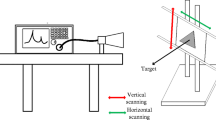Abstract
Radar sensing technology uses radio electromagnetic (EM) waves to provide 3D space localisation and 4D motion sensing. The mmWave radar shows advantages in low cost, low power, environment robustness and capability in material classification. In this paper, the capability of mmWave radar to perform industrial multi-material classification with obstruction is studied by measuring the reflected radar signal. The classified materials are common engineering materials which include metal, polymer, ceramic, composite and natural. The experiment is conducted using the IWR1443BOOST mmWave radar sensor. From a series of experiment results, the received radar signal is the unique material signature of a target object. The relative power measured by IWR1443BOOST is correlated to the target object’s relative permeability and permittivity. This indicated the mmWave radar can easily pick up unique material properties as well as the physical structure of target object with minor assistance from deep neural network model. Three models which are linear classifier, fully connected neural network (FCNN) and convolution neural network (CNN) are trained and inference on the radar signal. CNN shows the most robust performance even under noise, while linear classifier converges fastest. All models achieved satisfactory accuracy with minimum amount of training epochs. This is because the radar signals are having clear discriminative distribution as proven in standard deviation against mean plot. The models also perform under 16 mm thick obstruction and can classify less than 5 mm thin material. From the experiment, the mmWave radar provides highly accurate multi-material classification with deep neural network. Due to its’ capability in wall-penetration and environment robustness characteristics, mmWave radar is a new alternative solution for industrial automation and sensing application.
Access this chapter
Tax calculation will be finalised at checkout
Purchases are for personal use only
Similar content being viewed by others
References
Zhang, J., Feng, T., Yan, F., Qiao, S., Wang, X.: Analysis and design on intervehicle distance control of autonomous vehicle platoons. ISA Trans. 100, 446–453 (2020). https://doi.org/10.1016/J.ISATRA.2019.12.007
Karimi Pour, F., Theilliol, D., Puig, V., Cembrano, G.: Health-aware control design based on remaining useful life estimation for autonomous racing vehicle. ISA Trans. 113, 196–209. https://doi.org/10.1016/J.ISATRA.2020.03.032
Garnett, J.: The role of military power. In: Contemporary Strategy, pp. 50–64, Jan 2021. https://doi.org/10.4324/9781003104339-4
Zhong, R.Y., Xu, X., Klotz, E., Newman, S.T.: Intelligent manufacturing in the context of industry 4.0: a review. Engineering 3(5), 616–630 (2017). https://doi.org/10.1016/J.ENG.2017.05.015
Züfle, M., Moog, F., Lesch, V., Krupitzer, C., Kounev, S.: A machine learning-based workflow for automatic detection of anomalies in machine tools. ISA Trans. (2021). https://doi.org/10.1016/J.ISATRA.2021.07.010
Peng, Z., et al.: A Portable FMCW interferometry radar with programmable low-IF architecture for localization, ISAR imaging, and vital sign tracking. IEEE Trans. Microw. Theory Tech. 65(4), 1334–1344 (2017). https://doi.org/10.1109/TMTT.2016.2633352
Purvis, J.R., Al-Khalifa, A.: Artificial intelligence: can it be economically applied? ISA Trans. 28(1), 59–71 (1989). https://doi.org/10.1016/0019-0578(89)90058-X
Kumar, S.: Industrial robotics market forecast, trends to 2020, May 2015. https://www.researchgate.net/publication/275964852_Industrial_Robotics_Market_Forecast_Trends_To_2020. Accessed 26 Apr 2021
Barrett, D., Alvarez, A.: mmWave radar sensors in robotics applications, 2017. Accessed: 25 Apr 2021. [Online]. Available: https://www.ti.com/lit/pdf/spry311
Charvat, G.L.: Small and short-range radar systems. CRC Press (2014)
Barrett, D., Wang, D., Ahmad, A., Mahimkar, V.: Using mmWave sensors to enhance drone safety and productivity. Accessed: 26 Apr 2021. [Online]. Available: http://www.electronicdesign.com
Peng, Z., Li, C.: A 24-GHz portable FMCW radar with continuous beam steering phased array (Conference Presentation). In: Radar Sensor Technology XXI, vol. 10188, p. 41, Jun 2017. https://doi.org/10.1117/12.2257324
Koch, G.: Siamese neural networks for one-shot image recognition (2015)
Weis, J., Santra, A.: One-shot learning for robust material classification using millimeter-wave radar system. IEEE Sens. Lett. 2(4), 1–4 (2018). https://doi.org/10.1109/lsens.2018.2878041
Yeo, H.S., Flamich, G., Schrempf, P., Harris-Birtill, D., Quigley, A.: RadarCat: radar categorization for input & interaction. In: UIST 2016—Proceedings of the 29th Annual Symposium on User Interface Software and Technology, pp. 833–841, Oct 2016. https://doi.org/10.1145/2984511.2984515
Online, V.A., et al.: Recent advances on the electromagnetic wave absorption properties of Ni based materials. Eng. Sci. Publ. 3(23), 5–40 (2018). https://doi.org/10.30919/es8d735
Yeo, H.-S., Minami, R., Rodriguez, K., Shaker, G., Quigley, A.: Exploring tangible interactions with radar sensing. Proc. ACM Interact., Mobile, Wearable Ubiquit. Technol. 2(4), 1–25 (2018). https://doi.org/10.1145/3287078
Scientific brief: Modes of transmission of virus causing COVID-19: implications for IPC precaution recommendations. World Health Organization, 29 Mar 2020. https://www.who.int/news-room/commentaries/detail/modes-of-transmission-of-virus-causing-covid-19-implications-for-ipc-precaution-recommendations. Accessed 29 Apr 2021
Wu, C., Zhang, F., Wang, B., Liu, K.J.R.: MSense: towards mobile material sensing with a single millimeter-wave radio. Proc. ACM Interact. Mobile Wearable Ubiquit. Technol. 4(3), 1–20 (2020). https://doi.org/10.1145/3411822
Jamali, B., Ramalingam, D., Babakhani, A.: Intelligent material classification and identification using a broadband millimeter-wave frequency comb receiver. IEEE Sensors Lett. 4(7) (2020). https://doi.org/10.1109/LSENS.2020.3002715
IWR1443BOOST Evaluation board|TI.com: Texas Instruments (2021). https://www.ti.com/tool/IWR1443BOOST#description. Accessed 20 Oct 2021
Stratified K-Fold: Scikit Learn Documentation (2021). https://scikit-learn.org/stable/modules/generated/sklearn.model_selection.StratifiedKFold.html. Accessed 11 Nov 2021
Ebenezer, R.H.P.I.: Is there a rule of thumb that explains the splitting of a limited dataset into two-three subsets? 06 Nov 2015. https://www.researchgate.net/post/Is-there-a-rule-of-thumb-that-explains-the-splitting-of-a-limited-dataset-into-two-three-subsets. Accessed 20 May 2021
IWR1443: Texas Instruments (2021). https://www.ti.com/product/IWR1443. Accessed 06 Oct 2021
leopck: GitHub—leopck/iwr1443-material-dataset. Girhub, 05 Sep 2021. https://github.com/leopck/iwr1443-material-dataset. Accessed 06 Oct 2021
Gallagher, T.F., Cooke, W.E.: Interactions of blackbody radiation with atoms. Phys. Rev. Lett. 42(13), 835 (1979). https://doi.org/10.1103/PhysRevLett.42.835
Huo, J., Wang, L., Yu, H.: Polymeric nanocomposites for electromagnetic wave absorption. J. Mater. Sci. 2009 4415, 44(15), 3917–3927 (2009). https://doi.org/10.1007/S10853-009-3561-1
Xie, S., et al.: Recent progress in electromagnetic wave absorption building materials. J. Build. Eng. 27, 100963 (2020). https://doi.org/10.1016/J.JOBE.2019.100963
Acknowledgements
The authors wish to thank Phoong Stanley of Intel Corporation for supporting in the experiment.
Author information
Authors and Affiliations
Corresponding author
Editor information
Editors and Affiliations
Rights and permissions
Copyright information
© 2023 The Author(s), under exclusive license to Springer Nature Singapore Pte Ltd.
About this chapter
Cite this chapter
Leong, Y.S., Roy, S., Lim, K.H. (2023). Obstructed Material Classification Using mmWave Radar with Deep Neural Network for Industrial Applications. In: Das, B., Patgiri, R., Balas, V.E. (eds) Advances in Smart Energy Systems. Smart Innovation, Systems and Technologies, vol 301. Springer, Singapore. https://doi.org/10.1007/978-981-19-2412-5_8
Download citation
DOI: https://doi.org/10.1007/978-981-19-2412-5_8
Published:
Publisher Name: Springer, Singapore
Print ISBN: 978-981-19-2411-8
Online ISBN: 978-981-19-2412-5
eBook Packages: EngineeringEngineering (R0)




